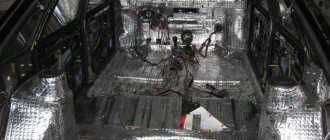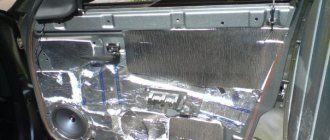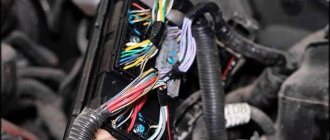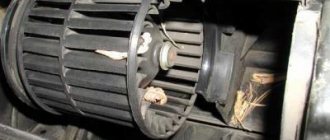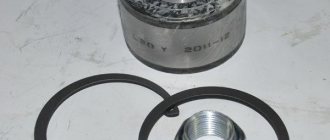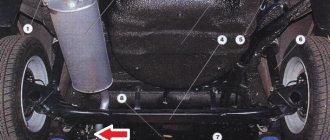Winter is the most unfavorable time of year for operating a car. This is primarily due to starting problems and prolonged warm-up of the engine.
But the dilemma can be easily resolved if certain measures are taken.
Below we consider the most important questions:
- How to insulate a car hood?
- What are the pros and cons of a car blanket, and how to use it correctly?
- What materials are used for thermal insulation?
- Why and how to close the radiator grille for the winter?
Let's consider each of the questions in detail.
Methods for insulating the hood
Many car owners are interested in what is the point of insulating the hood, because the manufacturer has already provided the necessary protection.
In fact, this is not enough. Additional protection is required to solve the following problems:
- Accelerate engine warm-up and reduce fuel consumption;
- Eliminates the appearance of ice on the surface of the hood, which negatively affects the paintwork of the car.
How to insulate the hood of a car and the engine compartment as a whole? The car owner has the following options at his disposal:
Buying a car kit for a motor.
This method of insulation has been known for several decades. The only thing is that our grandfathers used ordinary blankets.
Today everything is simpler, because there are specialized products on sale that can withstand high temperatures.
The advantages of a car blanket include high efficiency and safety in operation.
In practice, the warm-up time is reduced from 15 to 7-10 minutes, which saves fuel and extends engine life.
In addition, the use of a car blanket allows you to retain heat in the engine compartment longer after stopping.
If there is no blanket, the power unit cools down within 40-50 minutes. The use of insulation extends this period to four to six hours.
This feature is a big bonus for car owners who travel frequently.
Thermal insulation of the hood using special materials (this will be discussed below).
Many manufacturers have already provided noise and heat insulation on the inside of the lid.
But to increase efficiency, it is worth improving it yourself, without throwing away the factory protection.
Closing the radiator grille.
While driving, large volumes of cold air enter the engine compartment, which impairs the process of warming up the engine to the optimal temperature. One way to solve the problem is to close the grille.
This option can hardly be called ideal from an aesthetic standpoint, but it works.
In addition, it is recommended to provide motor protection to prevent precious heat from escaping through the lower part of the car.
Car products that the market offers
Today, there are several types of engine blankets that differ in material, characteristics and dimensions.
When choosing a product, you should focus on the following parameters:
- Car make (dimensions depend on this);
- Width;
- length;
- Weight;
- The presence of a cutout for a lock;
- Operating temperature requirements;
- Price.
Let's look at the main options:
Car blanket brand A-1.
This insulation is enough to keep the engine warm. The product is manufactured using the best materials, using modern technology and taking into account current standards.
Car blankets are resistant to chemical influences, the passage of electric current and excessive heat.
The operating temperature of A-1 brand products is in the range of -60 ... +650 degrees Celsius. At the same time, the covering material can withstand temperatures up to 650 degrees Celsius, and the blanket filler can withstand temperatures up to 1200 C.
This type of product is suitable for thermal insulation of gasoline and diesel engines.
Thanks to its dielectric properties, you don’t have to worry about accidentally shorting the terminals to the battery.
An important point is the size and the presence of special cutouts. That is why the choice of blanket should be made taking into account the model and make of the car.
Car blanket brand A-2.
Like the previous model, this is a universal product designed for insulation of various types of engines (running on gasoline or diesel).
The use of such a blanket in winter ensures quick warm-up of the engine, increases the service life of the battery and engine, and reduces fuel consumption.
Thanks to its resistance to negative influences (alkalies, acids, high temperatures), the car blanket can last for more than one year.
The main difference is the ability to work in a wide range of temperatures - from 60 degrees below zero to 1200 degrees Celsius.
A blanket of this brand is a dielectric, so touching the battery terminals does not lead to a short circuit.
Scope of application - insulation of engines of any equipment where internal combustion engines are installed.
The insulation contains the following materials:
- Silica tissue;
- Fiberglass threads;
- Mullite-silica wool.
Thanks to this composition, effective thermal insulation of the hood is ensured while retaining heat in the engine compartment.
The main advantages of a car blanket:
- Ability to withstand temperatures up to 1200 degrees Celsius;
- Long-term retention of engine heat;
- Non-flammable;
- Protection of the hood from ice formation.
There are many other modifications of car engine blankets. As a rule, the material from which they are made is the same, the only difference is in size and shape.
Advantages and disadvantages of car blankets
The best indicator of the quality of any product is reviews from real car owners. Car blankets are no exception.
Let's consider what good and bad users identified during operation.
Positive reviews:
- “Since I started using the car blanket, the car has warmed up faster, and the ice on the hood has disappeared. I also operated the car at temperatures below -35 degrees Celsius, so the use of such a product was 100% justified. I’m thinking of additionally insulating the engine compartment at the front and bottom.” Stas, 35 years old .
- “I used a car blanket on two cars and noticed that after turning off the ignition, the engine stays warm longer (on average by 20-30%).” Igor, 46 years old .
- “I’ve been using the car blanket for a month now and I’m pleasantly surprised by the results. The engine heats up faster, the interior warms up better, and fuel consumption has noticeably decreased. All this indicates excellent thermal insulation.” Nikolay, 28 years old .
Among the advantages it is also worth highlighting:
- High quality material;
- Additional sound insulation;
- Strength;
- High quality tailoring.
In addition to positive ones, you can also find negative reviews. Here are some of them:
- “I think I threw money away. The engine still takes longer to warm up than I expected, and cools down a little slower. You could just as easily insulate the hood with paper.” Evgeniy, 45 years old .
- “I recently read that using such a product can lead to lung cancer. The reason is that air passing through this material enters the car interior. So you should think several times whether to buy a blanket or not.” Dmitry, 34 years old .
- “After two months of use, I discovered a number of shortcomings - poor quality of tailoring, lack of proper efficiency and susceptibility to the negative effects of acids (after such liquids come into contact with the surface, the material is corroded). In the future, I plan to insulate the engine compartment using more radical methods.” Evgeniy, 44 years old .
Also the disadvantages include:
- High cost;
- Small thickness at the joints;
- Low efficiency (if installed incorrectly);
- Installation problems.
The process of insulating the hood using a car blanket
It was noted above that the easiest way to insulate the hood of a car is to use a car blanket.
If you choose the right product, it will ideally fit the dimensions of the engine compartment, and its installation will take a minimum of time.
All that is required is to throw a blanket over the engine and seal it around the perimeter. The main thing is that after installation there are no gaps left.
Basic rules of thermal insulation
- All necessary calculations are carried out based on the specific type of insulation and modification of the vehicle.
- The insulation is laid at air temperatures above +20 °C.
- Before laying the selected material, the internal engine compartment is cleared of dust and dirt. If there is rust, it should be treated as if it were going to be painted.
- Before directly installing the insulation, a paper template is first prepared and placed on it to check the accuracy of the future cut.
- Maximum attention and care should be taken, since it will not be possible to remove the thermal insulation material without damage in case of an error.
Alternative materials for hood insulation
In addition to the considered option, for thermal insulation of the engine you can use:
- Izolon. The advantage is effective heat retention and an affordable price. One square meter costs from 50 to 200 rubles (the price directly depends on the thickness). Advantages: reliable heat retention and high quality.
- Tiviplen-P - a material for thermal insulation that has a self-adhesive base. The main component is polyethylene foam. Moreover, the product itself consists of three layers - glue, polyethylene foam, exterior finishing. There is no foil here, but despite this, the product does an excellent job of retaining heat. The thickness of Tiviplena-P is four, eight or fifteen millimeters. Cost - from 220 rubles and above.
- Isoflex. When you need to insulate a car hood, this material comes in handy. Its advantages are double efficiency (sound and thermal insulation). On average, when purchasing such material you will have to pay 60-80 rubles per “square”.
- Stizol or Isoton — universal materials for heat and sound insulation. Sold in small pieces. One sheet costs 1700-2000 rubles.
- Felt. This is the simplest option that does not involve large costs.
Conclusion
Only a properly insulated hood of a vehicle, in particular the Lada Largus, will provide the opportunity for comfortable movement. And this is despite the coldest and frostiest weather that spoils Russian car owners every year.
Similar articles:
- Features of the gas stops on the hood of the Lada Largus and the nuances of their installation
- Features of deflectors on Largus
- Features of manufacturing and installation of the rear bumper trim of the Lada Largus
- Features of radiator grilles on the Lada Largus and its independent installation without removing the bumper
- Features of installation and tuning of mudguards in Largus
Do-it-yourself hood insulation
Thermal insulation of the hood is a labor-intensive process that requires the use of high-quality materials and strict adherence to the installation algorithm. The first step is to select the appropriate material.
To insulate the hood, you can use the following options (except for those already described above):
1. Without foil coating:
- PPE NH - heat and noise insulation material based on polyethylene. The product is distinguished by its affordable price, excellent performance characteristics, ability to retain heat and suppress unnecessary noise. It is used for thermal insulation of the hood, floor, luggage compartment, doors and other things.
- Splen 3004 - an affordable option that allows you to solve two problems at once (provide sound and thermal insulation). The peculiarity of splen is the presence of an adhesive layer, ease of installation and the absence of the need to additionally heat the product. Splen 3004 has a fine structure and is made using polyethylene. Dimensions (width, length) - 1,000 and 20 mm, respectively. The thickness is selected taking into account the tasks.
- Ultimate Soft Gray - foam rubber, characterized by decent characteristics and low price. It is used to provide heat and sound insulation of doors, trunk, floor and engine compartment. Roll parameters (width, length) - 500, 750 mm, respectively.
2. With foil:
- Ultimate Soft Gray with foil. A special feature is the presence of a thin layer of foil on the surface. The product is resistant to high temperatures and is suitable for heat and sound insulation of various parts of the machine. With its help, it is easy to insulate the car hood, luggage compartment, roof, doors and other elements of the car. The length of the material is 750 mm, the width and thickness are 500 and 10 mm, respectively (the latter parameter may vary).
- NPE - polyethylene foam, covered with a thin layer of foil on top. This combination provides powerful thermal insulation. In recent years, this material has been increasingly used in the organization of hood thermal insulation. Advantages: high quality, low price. Available in white and gray colors in rolls of 50 meters long and 100 cm wide. Thickness may vary.
- Isolontape 300 LA - characterized by the presence of a self-adhesive layer, as well as the ability to store heat, retain noise and moisture. Pros: reasonable cost, no odor and hygienic safety. Sold in gray and white, in rolls of thirty meters long and a meter wide. Thickness may vary. It is based on chemically cross-linked polyethylene foam. Often used for hood insulation.
To insulate the hood with your own hands, you should proceed as follows:
1. Prepare the necessary tools and material. To work you will need:
- Stationery knife;
- Scotch;
- Paper;
- Pencil pen);
- Marker;
- Scissors.
2. Make layouts taking into account the sizes of the hood sections. To do this, use cardboard or paper. Here it is important to make the workpieces with precision in order to avoid wasting excess heat-insulating material. As practice shows, to insulate the hood of a car, an average of 0.6-0.7 square meters of insulation is required.
3. Cut out all the blanks and sign with a marker (this will eliminate confusion during installation).
4. Attach the blanks to the heat-insulating material and outline the boundaries with a marker.
5. Carefully cut out the blanks that will later be glued to the hood.
6. Prepare the surface of the metal that is being processed. Wash the inner surface with a soapy solution, then let the surface dry.
7. Treat the metal with a degreaser to eliminate sagging.
8. Apply the prepared pieces to certain areas and stick them. Please note that it is not advisable to insulate the hood with glue. Use products with a ready-made adhesive layer.
If everything is done correctly and consistently, the hood insulation will be ready in 20-30 minutes.
In addition, with the correct choice of materials, it is possible not only to insulate the engine compartment, but also to improve the sound insulation of the car hood.
Insulation technology
- A pattern is cut out for the insulation material. Here you can use a roll of wallpaper that was not in demand after renovation work.
- Using clips, a piece of paper is attached to the engine compartment and a template of the required size is prepared along its contour. The protrusions under the ribs are also fixed in parallel.
- The pattern is applied to previously prepared pieces of heat-insulating material. Most often there are several of them: from two to three.
- All cut out parts are glued into one whole.
- In the finished product, punctures are made for the clips, which must coincide with all the engine compartment holes. These parts fix the insulation, after which the excess is cut off with a knife.
Closing the car grille
The final touch in the matter of thermal insulation is the closing of the radiator grille, through which cold air flows. If nothing is done, insulating the hood will not give much results.
The car owner has several options at his disposal:
- Using ordinary cardboard (this option is often found on Gazelles). For obvious reasons, it is not suitable for passenger cars.
- The use of special radiator grilles in which the blinds are closed (available for some models of foreign cars).
- Preparation and fastening of a suitable piece using foil insulation.
Next, it wouldn’t hurt to soundproof the car’s fender liner.
Why is insulation used?
The hood insulation is a very important thing that helps you use your Largus car comfortably and without problems. It is necessary to install this element for the following reasons:
- Noise insulation;
- Cold engine start.
The first reason is that when you install insulation for the hood, the noise from the engine will be less transmitted outside and into the cabin, and accordingly this will increase your comfort while driving.
But this is not the most important thing. A large number of people are faced with the fact that it is difficult to start the engine in winter, and sometimes impossible on diesel cars, because the fuel can simply freeze. To do this, you have to create conditions so that the motor is relatively warm. For Largus, the problem is solved simply - by installing insulation on the hood. You can also use a special blanket that is simply placed on top of the engine. By the way, shorter warm-up time means fuel savings, and this is another argument in favor. As a rule, this is sufficient for normal climate conditions without severe frosts.




